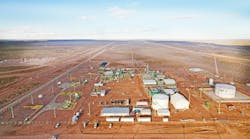Sam Fletcher
Senior Writer
Crude futures prices escalated to record highs in four out of five trading sessions Aug. 8-12 on the New York Mercantile Exchange as traders worried about supply disruptions, political tensions, an unusually active hurricane season, and strong refiner demand for light, sweet crude.
With less than a month left in the US summer driving season, about a dozen refineries unexpectedly were forced to reduce capacity in recent weeks. Meanwhile, US demand for gasoline had grown by 1.4% from year-ago levels in recent weeks.
The September contract for benchmark US light, sweet crudes jumped by $1.63 to $63.94/bbl Aug. 8 on NYMEX before falling to $63.07/bbl in the next session. The contract rebounded to $64.90/bbl on Aug. 10 and climbed to $65.80/bbl on Aug. 11. It finished the week at a record front-month closing of $66.86/bbl, having touched a 22-year high of $67.10/bbl during trading on Aug. 12. Subsequent crude futures contracts through May 2006 all finished above $67/bbl on NYMEX.
In London, the September contract for North Sea Brent crude hit an all-time front-month high of $66.77/bbl during trading Aug. 12 before settling at a record $66.45/bbl on the International Petroleum Exchange.
Meanwhile, the International Energy Agency, in its Monthly Oil Market Report released on Aug. 11, lowered its 2005 outlook for Chinese demand growth to 4.9% from 5.5%, or 40,000 b/d. That was offset by higher demand projections for the US and Japan.
"More importantly, it revised its non-OPEC supply estimate downward for this year by roughly 200,000 b/d and for 2006 by 370,000 b/d due to lower projected output from the US, Mexico, Norway, the UK, and Russia," said Robert S. Morris, Banc of America Securities, New York, in an Aug. 15 report. That increases the expected call on crude oil production from the Organization of Petroleum Exporting Countries, "whose current spare capacity is estimated to be no more than 2 million b/d—predominantly heavy or sour crude—(that) matches the projected increase in global demand projected for the fourth quarter," Morris said.
IEA's outlook
IEA blamed "unscheduled summer [production] outages in North America and the North Sea" for contributing to a downward revision in 2005 non-OPEC supply to 50.8 million b/d. However, it said, "Non-OPEC supply is expected to rebound by 1.25 million b/d in 2006 to average 52 million b/d. Higher OPEC volumes underpinned a 250,000 b/d rise in July world oil supply to 84.7 million b/d."
According to IEA, OPEC crude supply increased by 285,000 b/d, to 29.6 million b/d in July. "Main increases came from the UAE, Saudi Arabia, Iran, and Iraq. The call on OPEC crude and stock change remains at 28.2 million b/d for 2005 but reaches 29.2 million b/d in the fourth quarter. The 2006 call is revised up by 240,000 b/d to 28.3 million b/d," it said.
IEA analysts noted the "erratic" relationship in recent years between oil demand and economic growth as measured by gross domestic product.
"The latest upward revisions to US oil demand and downward revisions to its GDP growth for 2004 have exacerbated the divergence in their traditional relationship," IEA report said. "It has also raised questions over the level of US oil demand growth reported so far in 2005. Similarly, slow apparent oil demand growth in China in 2005 runs counter to a near double-digit expansion in GDP."
Fluctuations in US and Chinese oil demand growth "are by no means isolated cases," IEA said. But they aggravate uncertainty and increase market concerns about capacity constraints. A sharp rise in stocks among members of the Organization for Economic Cooperation and Development in the first half of 2005, combined with substantial improvement in the US distillate stock position, "has clearly provided insufficient comfort to a US market facing a heavy autumn refinery maintenance schedule and an active hurricane season." Signs of increased oil-company investment haven't "dispelled the view that oil companies have switched from a position of just-in-time inventory to one of just-in-time capacity," IEA said. "Higher oil prices have brought about a limited demand-side and substitution response. They have not completely choked off oil demand growth. Neither (so far) has the impact been sufficient to reverse economic growth, and that is no bad thing," IEA reported.
The past few years have shown, the agency said, that "successfully micromanaging supply is a nigh-on impossible task: The tighter the capacity, the higher the level of stocks needed to compensate."
(Online Aug. 15, 2005; author's e-mail: [email protected])
